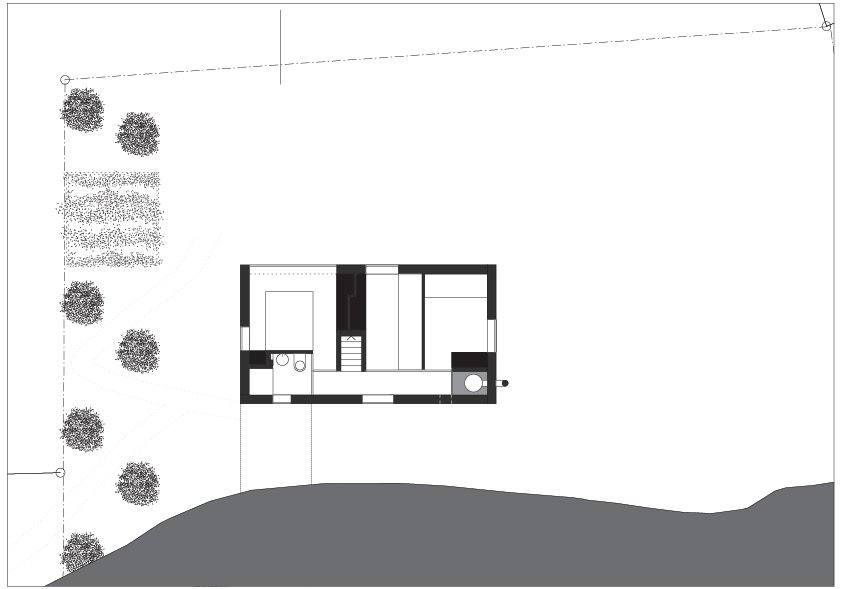Digital and fabrication advances have renewed designers’ interest in factory-built housing (Gonchar 2008). Contemporary prefabricated homes have shed the stigma that once saw them regarded as monotonous and technically inferior to conventionally constructed units (Trulove and Cha 2007). In Japan, for example, more than 120,000 houses per year – one third of all newly built homes – are made in a factory (Davies 2005). This rising trend can be attributed to their financial, environmental, structural and timesaving advantages (Elliot 2005, De Garrido 2008). Furthermore, constructing houses in a factory negates problems related to on-site construction such as vandalism, material storage and weather delays. Factories also require fewer skilled workers and therefore construction becomes cheaper. Another major advantage of prefabrication is the time consideration. An efficient, high-tech factory can produce a house in a week, in comparison to on-site construction, which, on average, takes more than five months (Elliot 2005).
There are three principal methods of prefabrication: modular, panellized and the kit-of-parts (Friedman 2005). Modular prefabrication consists of constructing large finished sections in the plant, which are then transported to a site, placed on a preprepared foundation and joined together with the help of a crane. This method requires the least site work. The panellized method involves manufacturing wall panels and floor sections, which are then shipped to a building site for assembly. In a kit-of-parts, a machine cuts each piece and labels it for site assembly by a skilled contractor. This method takes the longest to assemble and is more suitable for complex structures where saving time is less of a concern. There are numerous types of prefabricated systems, subsystems and components that can be combined at various levels to provide a complete system package. Panellized prefabrication, however, is probably the most widely used, therefore it is discussed below.
Nine types of panel systems are applicable to wood-frame residential construction. They can be divided into three categories: (1) open-sheathed panels (using conventional construction methods); (2) structural sandwich panels; and (3) unsheathed structural panels.
Open-sheathed panels (OSP): These are available in almost as many different variations as conventional wall construction. The most common systems are built with 38 x 140 mm (1.5 x 5.5 in) studs with plywood or waferboard sheathing, or with 38 x 89 mm (1.5 x 3.5 in) studs and extruded polystyrene sheathing. In either case, the panels are delivered open to the interior to facilitate the installation of electrical and/or plumbing services. Batt insulation is usually installed on-site, and is sometimes supplied by the manufacturer.
Structural sandwich panels (SSP): Also known as foam-core panels, these consist of a core of rigid foam insulation, which is laminated between two facing materials. In its most basic form, the sheathing materials may be either plywood or waferboard. More complete options offer exterior and/or interior finishes that replace the basic facing material and become an integral structural part of the panel.
The core material contains pre-cut electrical chases, and may be one of four different types of insulation: moulded bead expanded polystyrene; extruded polystyrene; polyurethane or polyisocyanurate. A variety of options are available for the joints between the panels.
Unsheathed structural panels (USP): USPs, or composite panels, are built using wood or metal structural elements combined with rigid foam insulation infill, usually expanded polystyrene. There are four basic variations of these systems available with different configurations for their structural elements, which provide a continuous thermal break and/or an air space in the interior of the panel. Horizontal chases for electrical wiring are often cut into the insulation to accommodate electrical wiring.
For each of the systems, it is possible to ‘add value’ to the panel by integrating a larger portion of the building envelope during fabrication. Added components vary from air barriers to exterior and/or interior finishes. The extent to which the panels are finished has different implications for the builder and the worker who will select and install the system.
One of the most significant advantages of prefabricated panel systems is the superior quality that can be achieved through the manufacturing process. This quality can be evaluated based on three interrelated characteristics: craftsmanship, technical performance and durability. The system’s craftsmanship governs its potential to achieve consistent levels of performance from one application to another. The wall’s technical performance, particularly with respect to its air-tightness, will affect the rate of deterioration due to condensation. Fire and sound resistance, critical for dividing walls, will contribute to the quality of the unit’s interior environment. The panel’s durability depends on the various materials’ resistance to several elements, and on the probability of exposure to these, given the panels’ designs.
Prefabricated panel systems are generally capable of technically outperforming walls built using conventional construction methods. Structural sandwich panel systems, particularly those with urethane or isocyanurate foam, provide excellent insulation value for a given thickness. This is partly due to their continuous thermal break across the joints, particularly with the double spline variation. These panels also result in the tightest assemblies, due to their exceptionally well-fitted joint systems and the possibility of extending the exterior skin below the floor level, allowing for a continuous barrier across the end of the floor section. High performance levels are easy to achieve due to the inherent simplicity of the design. The critical nature of the lamination process, however, requires a relatively high level of quality control. Among the questionable characteristics of this panel type is a susceptibility of these systems to ridge at the joints because of inadequate allowance for thermal expansion, and the possibility of panels delaminating.
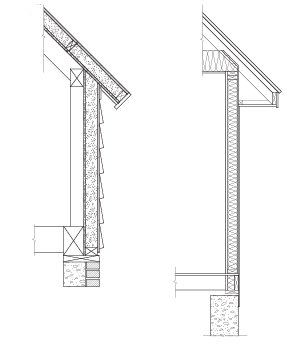
Figure 7.1 Comparison between panellized (left) and conventional (right) fabrication methods.
Unsheathed structural panels appear to provide good performance in all respects, but benefit from few extraordinary characteristics. The panels’ biggest advantage is that they can overcome the inadequate workmanship that may be encountered in conventional construction without resorting to very unfamiliar building techniques. The use of expanded polystyrene foam between the structural elements significantly improves the performance of the wall in that area, which is a key failure point in conventionally built walls: discontinuous insulation and an air barrier caused by improper installation. Tight friction-fit joints and the ability to accommodate electrical boxes without interrupting the continuity of the insulation is an attractive advantage over conventional construction methods. Furthermore, the relatively simple manufacturing techniques (some make no use of adhesives) provide continuous thermal breaks and adequate air barriers, making them likely to achieve consistent performance levels.
As is the case with any manufactured component, the waste generated by the prefabrication of panel systems is less than could be expected from site construction. Assembly of the wall system in closed, controlled environments ensures that materials are used efficiently, and ‘scrap’ pieces of materials are more easily recovered and reused. Furthermore, the fact that the unit is closed within a short period of time reduces delays due to bad weather. Since there is less material wastage, the cost of clearing and removing debris is also lowered.
Despite the fact that prefabrication has already advanced as a result of innovation, there are plans to push the practice even further. These plans include using products made of recycled materials, online design and a choice of interior components by customers according to their spacial needs and budget (Duran 2008).
DRIVING FORCES
•Need to reduce cost
•Technological advances
•Need for energy efficiency
•Public interest in prefabrication
INNOVATIONS
•Better design and nicer appearance
•Automation/robotics
•Computer-aided design
•Multiple-use areas
•Higher energy efficiency standards

Figure 7.2Wall sections of conventional wood-frame construction (left) and one with structural sandwich panels (right).
7.1 PREFABRICATED DWELLINGS | |
Project |
Wood House in Caviano |
Location |
Caviano, Switzerland |
Architect |
Markus Wespi Jérôme de Meuron Architects BSA |
Wood House is located in the hills at the edge of Caviano, Switzerland. The area, just outside the historical centre of Caviano, is filled with a mix of building types. Therefore, the intention of the architects Markus Wespi and Jérôme de Meuron, was to create a simple house that relates to the adjacent natural stonewalls rather than to the existing structures. The selection of inexpensive materials and the use of simple detailing optimized the overall cost of the 65-m2 (700-sq ft) project. While the dark silver-grey toned facade blends in with the surrounding colours of the mountainous rocks, the use of prefabricated timber components both inside and outside is noticeable.
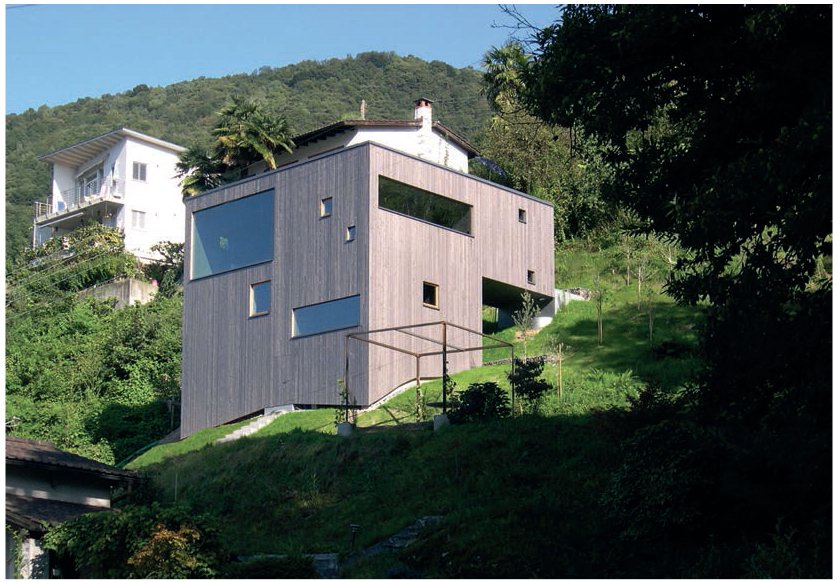
The dark silver-grey tone of the facade blends in with the surrounding colours.
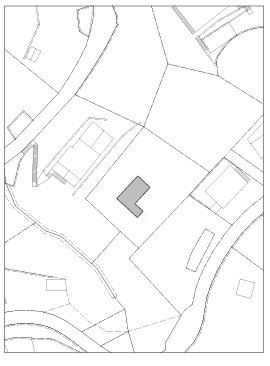
Site plan.
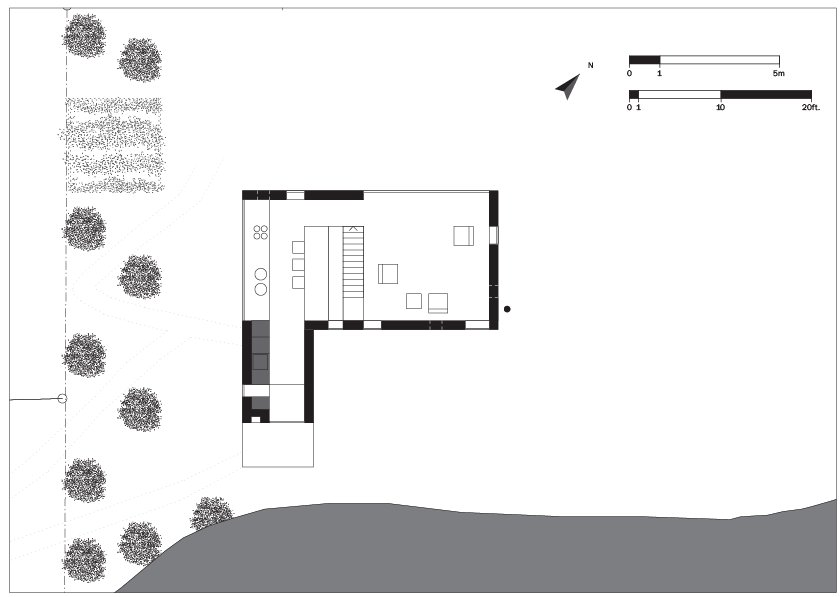
Upper-floor living area (top), bedrooms floor (bottom)
West view.
In general, without the use of drywall and baseboards to cover large areas, it is quite hard to produce modern detailing at a lower cost. Therefore, to enhance the visual experience without raising construction cost, the interior partitions, which were clad with oriented strand boards (OSB), remained exposed. Doors, cabinets and built-in tables were all made from OSB to achieve a uniform look. Similarly, they were painted in a dark silver-grey tone similar to that of the facade. In addition, no moulding or decorations were used where walls and glass partitions meet the floors and ceilings.
The two-level access provides direct entrances to both floors of the house. The kitchen and living areas are situated on the first floor in order to take advantage of the beautiful scenery. The ground floor contains three bedrooms and a washroom. To avoid unnecessary expenses and heat loss, the large, fixed windows differ from the smaller square ones, which can be opened for ventilation.

North view.

The kitchen area.
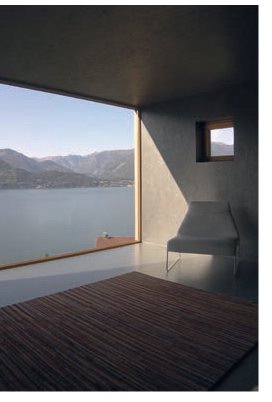
View from the living room.
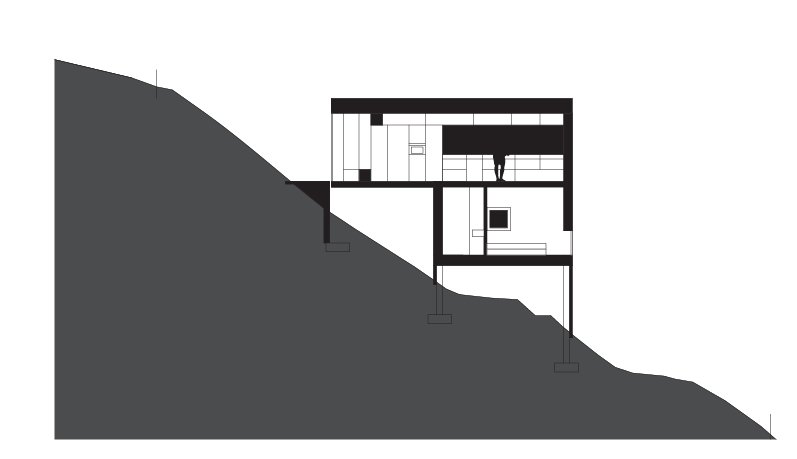
Section showing the upper living area and the lower-level bedrooms.
7.2 PREFABRICATED DWELLINGS |
|
Project |
Zufferey House |
Location |
Wallis (Valais), Switzerland |
Architect |
Nunatak Sarl |
Located in Wallis, Switzerland, the Zufferey House is sited on a hilltop between the eastern and western L’Archavaz Mountains. Designed by Nunatak Architects Sarl, the dwelling’s overall appearance, which can be interpreted both as complementing and contrasting to its environment, was inspired by the surrounding mountains and their visual qualities. The house has a total floor area of 185 m2 (1,990 sq ft) on two levels. Nicknamed ‘Angle’, the house is aligned with the sloping elevation of the terrain and its facade is clad with natural grey slate that mimics the nearby rocks.
The house, which does not follow common vernacular construction practices, uses prefabricated panels, which save on labour and materials costs. Panellized wall sections were first manufactured and assembled in a factory, then shipped to the site for installation. The interior walls are covered by painted wood particle panels while the exterior panels contain thermal insulation. The house’s grey, polished concrete flooring includes a heating system to form an ‘active slab’. Indoors, there is a delightful combination of concrete slab and wooden ceilings and trims, as well as glass windows.
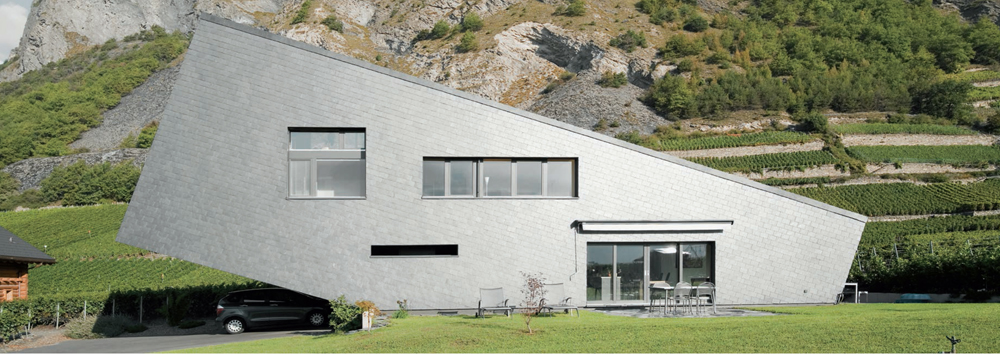
The shape of the house was inspired by the surrounding mountains.

The living spaces, kitchen and guest bathrooms are located on the ground floor, and private bedrooms and bathrooms are on the first. The family’s living space was extended to the outdoors by forming a terrace and a garden. Passive solar design principles also protect the occupants from summer heat and wind from the western valley. At the northern end of the house, the overhang design provides protection from the elements to the entrance and parking spaces.
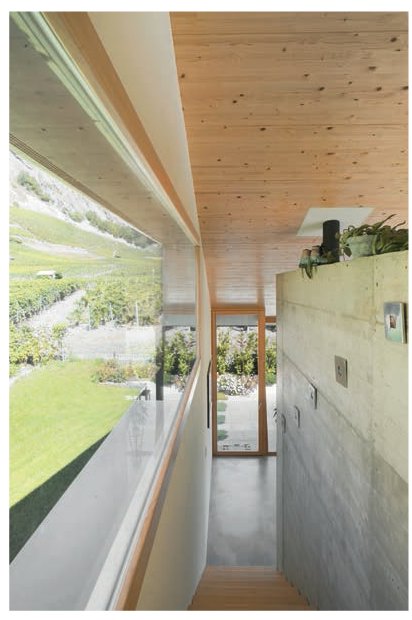
View into the combined living, dining and kitchen areas.
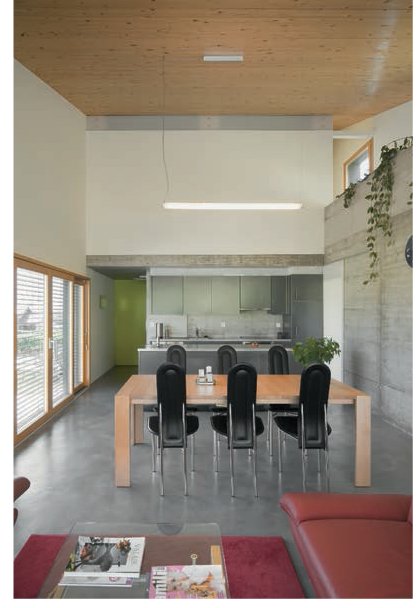
The elongated stair and passageway along the exterior wall.
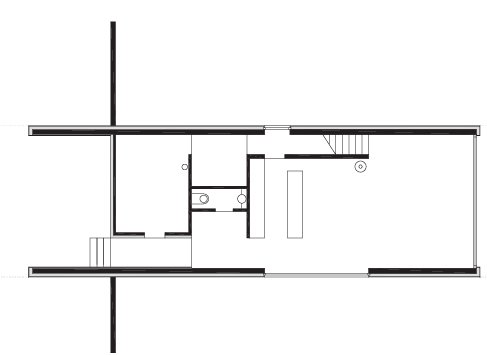


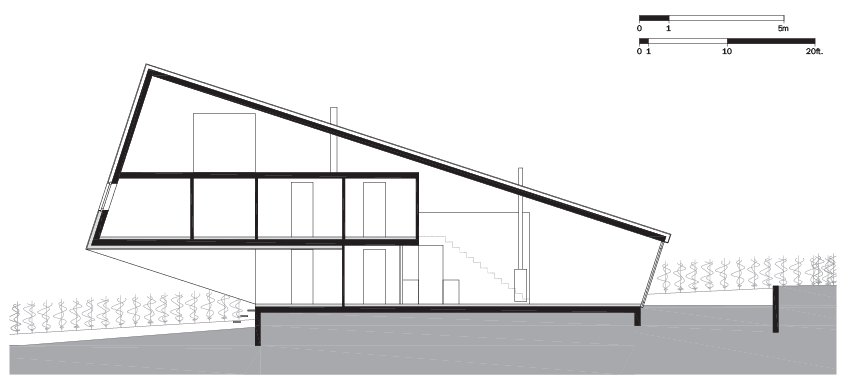
Floor plans and cross-sections which demonstrate the modularity of the design.

